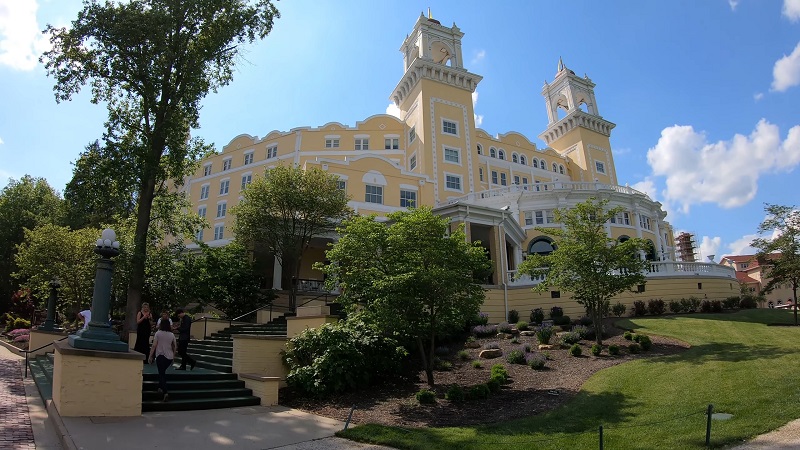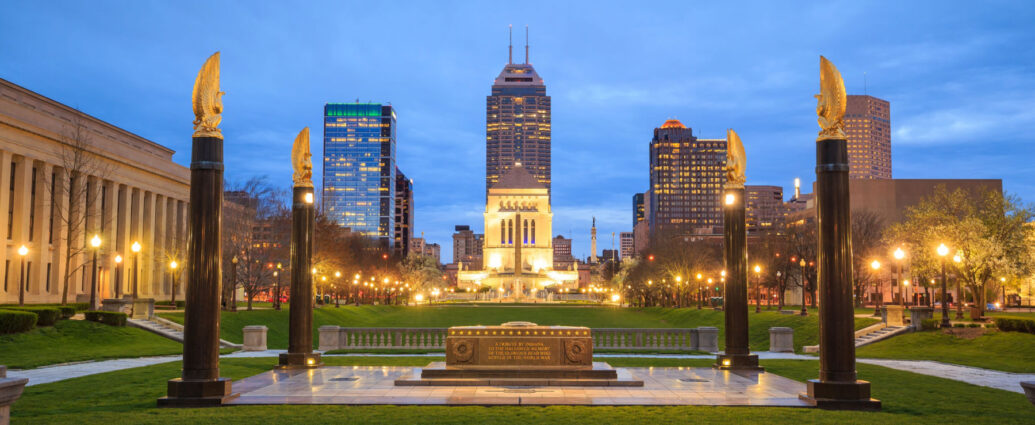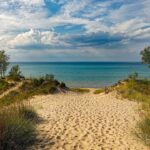Indiana holds key parts of America. Each courthouse, battlefield, and homestead shows where change took place. The state played a strong role in the frontier, the push for freedom, and the rise of industry. It helped shape early law, westward growth, and bold ideas.
Many sites across Indiana tell clear stories. Some show where people found safe passage. Others mark strong resistance by Native nations. Some show the path of invention and progress. Each one connects to a major part of the national past.
Each landmark stands as a clear voice. The story of America runs through Indiana, town by town, stone by stone.
1. Homes and Stations on the Underground Railroad
Indiana carried risk and courage through quiet farm roads and Quaker homes. People with no weapons stood against one of the most brutal systems in American history. Some opened their doors. Some built false walls. Some gave no names and asked for none. They acted without reward.

In Fountain City, a brick house still stands where more than one thousand enslaved people passed through on their way north. The Coffin family made it known that no person would be turned away. Food, fire, blankets, and silence built the network that helped people escape.
In Jefferson County, Lyman and Asenath Hoyt turned their home into a hiding place. Outside looked plain. Inside held secret chambers, passage doors, and coded tools. Farther south, students at Eleutherian College, both Black and white, studied side by side. They prepared for a different world while the war loomed closer.
Signals That Meant Safety
- A candle in the front window
- A quilt on the fence in daylight
- A lantern swinging after dusk
Don’t forget to read more about the catacombs.
2. Native Towns and Sacred Ground
Long before state lines, roads, or counties, great towns rose along rivers in Indiana. Thousands gathered in wide plazas. They built mounds from earth, layer by layer, for burials, rituals, and power. Their leaders watched the sky, read the land, and built homes from what grew nearby.

Angel Mounds near Evansville once held a strong Mississippian town. Between 1100 and 1400 AD, people lived in a grid of homes, tracked trade routes, and raised platform mounds for leaders and ceremonies. They left no written record. They left earth, tools, and patterns that speak for them.
At Mounds State Park near Anderson, ancient circles made of earth still hold their shape. Built by the Adena and Hopewell cultures, these rings align with the sun and moon. They do not sit in silence. They still mark time.
What Remains Today
| Site | Approximate Date | Features |
|---|---|---|
| Angel Mounds | 1100 to 1450 AD | Platform mounds, plazas, homes |
| Mounds State Park | 160 BC to 50 AD | Solar-aligned earthworks |
| Fort Ancient connections | Pre-1000 AD | Regional cultural links |
3. Frontier Wars and Early Resistance
Indiana stood at the edge of war long before it joined the Union. On wooded trails and muddy rivers, Native nations and American troops met in open conflict. Some called it expansion. Some called it invasion. Each side fought with full force.
In 1811, William Henry Harrison marched toward Prophetstown, where Tecumseh’s confederation tried to hold ground. At Tippecanoe, the battle lasted two hours. Smoke hung in the air by dawn. The result gave the U.S. Army control of more land, but it came at a deep cost to Native power in the region.
Prophetstown had meaning far beyond war. It stood as a capital of resistance. It brought together tribes that once stood apart. It tried to hold the line against broken promises and growing settlement.
Events That Shaped the Land
- 1794: Battle of Fallen Timbers
- 1809: Treaty of Fort Wayne, signed under pressure
- 1811: Battle of Tippecanoe
- 1813: Death of Tecumseh at Battle of the Thames
4. Where Lincoln Grew Up
Before the speeches, before the war, before the White House, Abraham Lincoln lived in southern Indiana. His family moved there in 1816, the same year Indiana became a state. He chopped wood, read by firelight, and buried his mother in the woods nearby. Every part of that land shaped his mind, his views, and his strength.

Lincoln Boyhood National Memorial in Lincoln City marks the spot where he lived for fourteen years. A simple cabin sits there now, built to match the one his family called home. Nearby, Nancy Hanks Lincoln rests beneath a modest headstone in a quiet cemetery. That loss, at age nine, left deep marks on her son.
Visitors walk past split-rail fences and rough trails. They see the field where Lincoln once held a plow. They hear about the schoolhouse that sparked his love for reading. The site does not use grand monuments. It uses silence, space, and story.
Key Features at the Memorial
- Pioneer cemetery with Nancy Lincoln’s grave
- Living Historical Farm with seasonal demonstrations
- Replica of Lincoln family cabin
- Museum with documents, tools, and early images
5. Industry, Mills, and Midwest Power

Indiana’s land gave more than crops. It gave stone, timber, water, and the power to build. Before steel giants ruled the north, mills shaped towns and pulled families into the wage economy. They stood by rivers, smoked through winters, and drew people into tight rows of houses and hard hours.
In Cannelton, the old cotton mill still rises over the Ohio River. Built in 1849, it became the largest industrial building west of the Alleghenies at the time. It made cloth, but it also made noise, order, and a new kind of work life. Workers came by boat, on foot, and later by rail.
Madison, on the river’s edge, tells a different story. Its early mills used the river for transport and steam. Its Main Street still holds the homes of factory owners and merchants who watched industry turn soil into wealth. Across southern Indiana, clay turned into brick, limestone into buildings, and forests into lumber for cities far away.
Key Industrial Sites
- Cannelton Cotton Mill (1849): Romanesque style, still intact
- Madison Historic District: More than 100 blocks tied to early industry
- Bedford and Bloomington: Known for limestone quarries used in national buildings
6. Monuments to War and Memory
Indiana gave soldiers to nearly every major U.S. war. Town squares across the state hold names carved in granite. Some tell of local regiments. Some carry words like honor, sacrifice, and duty. Others rise as national symbols, shaped by victory and grief.

At the heart of Indianapolis stands the Soldiers and Sailors Monument. Finished in 1902, it towers above the city with stone figures, iron gates, and fountains below. The monument honors Civil War soldiers but later expanded to include other conflicts. No visit to the capital feels complete without standing beneath its shadow.
Farther west, in Vincennes, the George Rogers Clark Memorial tells of a different kind of war. It honors the 1779 victory that gave the United States control of the Northwest Territory. Inside the grand domed building, murals show men crossing frozen rivers to surprise the British at Fort Sackville.
Notable Memorials in Indiana
| Name | Location | War/Event |
|---|---|---|
| Soldiers and Sailors Monument | Indianapolis | Civil War and later additions |
| George Rogers Clark Memorial | Vincennes | Revolutionary War |
| Veterans Plaza and Museum | Lawrence | Multiple 20th-century conflicts |
7. The Car that Changed the World
The world knew what a car was, but few places changed how we drove like Indiana. Long before electric cars or high-speed trains, one company led the way. The Indianapolis Motor Speedway became the symbol of speed and power in the early 20th century, as drivers raced into the future.
In 1909, the Speedway opened. The first Indy 500, held in 1911, captured the nation’s attention. From that moment, racing became more than a sport. It became a showcase for technology, skill, and American determination. The track itself is a landmark. The cars are part of history. Today, the Indy 500 is a fixture of both racing and popular culture.
But the cars that came out of Indiana’s factories told a different story. In Auburn, the Duesenberg brothers built luxury cars with innovation at their core. The Duesenberg Model J, introduced in the 1920s, was a masterpiece of engineering, speed, and luxury. These cars didn’t just get people from one place to another. They made a statement.
Key Highlights in the Car Industry
- Indianapolis Motor Speedway: The birthplace of the Indy 500, the longest-running car race in the world.
- Auburn Cord Duesenberg Museum: Celebrates the rich legacy of Indiana’s automotive pioneers.
- Duesenberg Model J: One of the most iconic luxury cars in American history.
8. Grand Hotels, Healing Waters, and the Gilded Age
In the late 19th and early 20th centuries, Indiana attracted travelers looking for more than just a bed and a meal. The wealthy and the powerful flocked to grand hotels where opulence met innovation. Many of these places promised not only comfort but also health—often through mineral waters that were believed to heal the body and soul.

At West Baden Springs Hotel, visitors found a retreat unlike any other. Opened in 1902, the hotel’s stunning dome stood as the largest free-spanning dome in the world at the time. The resort’s lavish interiors drew people seeking luxury, while the surrounding waters offered a claimed cure for ailments.
Nearby, French Lick Resort stood as another beacon of luxury. First opened in 1845, French Lick was known for its mineral springs and expansive grounds. By the early 1900s, it had evolved into a world-class resort, hosting not only vacationers but also politicians, celebrities, and business moguls.
Famous Resorts and Hotels
| Hotel | Location | Feature |
|---|---|---|
| West Baden Springs Hotel | West Baden Springs | Largest free-spanning dome in the world |
| French Lick Resort | French Lick | Mineral springs, luxury |
| Hotel Petersburg | Petersburg | Historic Gilded Age retreat |
FAQs
1. What are some other notable Underground Railroad sites in Indiana?
While the Coffin House and the Hoyt House are well-known, other important stops include the Robert and Catharine Knight House in Knightstown and the John W. H. McCormick Farm near Covington. These sites also played a significant role in aiding enslaved people on their journey to freedom.
2. How did Indiana’s Native cultures influence early U.S. settlements?
The Native tribes in Indiana, such as the Miami, Shawnee, and Potawatomi, had established trade networks and agricultural systems that significantly impacted the early settlers. Their knowledge of the land, especially regarding natural resources like rivers and fertile soils, helped settlers thrive in the region.
3. How did the industrial growth in Indiana influence national markets?
Indiana’s industrial growth, particularly in the steel, coal, and limestone industries, became a key component of America’s economic expansion. The state’s access to waterways allowed for efficient transport of raw materials, boosting manufacturing across the nation.
4. What is the historical significance of the Duesenberg car company?
Duesenberg cars were not just about luxury; they represented American engineering at its finest. The Duesenberg Model J, for example, was the epitome of style and speed during the early 20th century. It set the standard for what luxury automobiles should be and became a symbol of America’s industrial prowess.
5. Why is the history of mineral springs in Indiana important to American tourism?
The mineral springs at West Baden and French Lick were once major health destinations in the U.S., attracting visitors from across the country. These resorts not only provided health treatments but also influenced early tourism, establishing the region as a center for relaxation, luxury, and healing in the Gilded Age.
Last Words
Historic landmarks in Indiana stand as markers of change, telling stories that shaped the nation. The state’s history is built on battles fought, lives changed, and ideas tested. These sites are the places where the struggle for freedom, innovation, and resistance unfolded, each one a piece of the broader American journey.
Indiana’s past, from its earliest settlements to the industrial rise, is written in these locations, offering a raw look at the challenges and triumphs that defined America.



